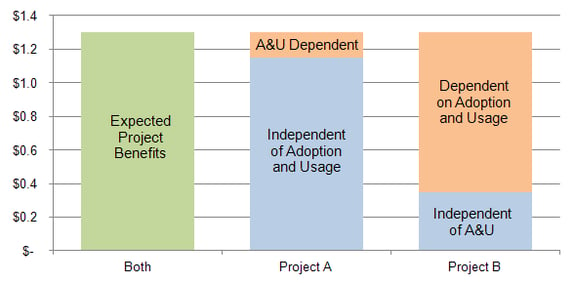Rethinking the ROI of Change Management

6 Mins
Updated: September 10, 2025
Published: August 23, 2018

Successful organizational change isn't accidental—it's measurable, intentional, and directly tied to your bottom line. Many change management professionals find themselves constantly challenged to prove the value of managing the people side of change. In fact, while project management and leadership rarely face scrutiny about their ROI, change management continues to be questioned.
By quantifying the people-side benefit contribution to change success, we can calculate the change management return on investment (ROI), providing content for meaningful and enlightening conversations with project leaders and executives to build buy-in and commitment to change management.
The key is to shift our conversation from "What is the ROI of change management?" to "What amount of the project benefits (ROI) depends on employee adoption and usage?"
The ROI of change management is the additional value created by a project due to employee adoption and usage. The process below empowers you to capture and express a quantified value for change management's contribution.
Understanding Change Management ROI
Return on investment (ROI) is typically calculated by dividing the net benefits (benefits - costs) by the project costs. However, not all project benefits are created equal. We can break down expected project benefits into two critical categories:
-
Independent of Adoption and Usage – These benefits occur regardless of employee engagement. For example, replacing a software program with lower maintenance and license fees.
-
Dependent on Adoption and Usage – These benefits are realized only when employees effectively adopt and use the new system or process. For instance, a new software that not only reduces costs but also improves data accuracy and reduces errors through proficient use.
When we divide the net benefits (benefits - costs) by the project costs, we calculate the value captured by undertaking the effort. Project leaders and senior leaders are comfortable and familiar with this sort of analysis.

In order to shift the change management ROI (CMROI) discussion, let's break apart the expected project benefits. Some of the benefits will be independent of adoption and usage. For example, suppose we are replacing a particular software program that has lower maintenance and license fees. Those benefits are achieved regardless of adoption and usage. Those would fall into the first category, "Independent of adoption and usage."

The other branch of expected project benefits includes those that are in the category of "Dependent on adoption and usage." Suppose our new software program not only has lower maintenance and license fees (the independent benefits), but if it is used proficiently by employees, it produces more accurate and timely data, increasing performance and reducing errors. Those additional benefits result from impacted employees adopting and using the new system effectively.
The amount of project benefits that are dependent on adoption and usage is what we can capture/ensure/drive/realize through successful change management.
How to Calculate Change Management ROI
With that foundation, here are two examples that illustrate the people-side benefit contribution, which is what we will call the project benefits that are dependent on adoption and usage.
|
|
Project A: Hardware upgrade |
Project B: Process optimization project |
|
Expected Project Benefits: |
$1,300,000 |
$1,300,000 |
Both Project A and Project B have the same expected project benefits ($1.3 million). However, we intuitively know that the benefits associated with a hardware upgrade and those from a process optimization are different. We'll add a line to our table that addresses the people impact of each project.
|
|
Project A: Hardware upgrade |
Project B: Process optimization project |
|
Expected Project Benefits: |
$1,300,000 |
$1,300,000 |
|
People Impact |
Quite small. Only a handful of employees are impacted in terms of their day-to-day work. |
Quite large. Many employees will have to do their jobs a new way, and it is their adherence to the new processes that ultimately drives much of the expected value from optimization. |
To arrive at the people-side benefit contribution, we ask a simple (yet thought-provoking) question:
What would the expected benefits be if adoption and usage were 0?
In other words, if no employees change the way they do their job when this project goes live, how much value would be realized? With this data, we can begin to demonstrate the value change management can deliver. Extending the example, we might arrive at these values when adoption and usage are 0:
|
|
Project A: Hardware upgrade |
Project B: Process optimization project |
|
Expected Project Benefits: |
$1,300,000 |
$1,300,000 |
|
Expected Benefits if adoption and usage are 0: |
$1,150,000 |
$350,000 |
By subtracting the expected benefits when adoption and usage are 0 from the expected project benefits, we arrive at the amount of project benefits tied to adoption and usage—what we are calling the people-side benefit contribution.
|
|
Project A: Hardware upgrade |
Project B: Process optimization project |
|
Expected Project Benefits: |
$1,300,000 |
$1,300,000 |
|
Expected Benefits if A&U = 0: |
$1,150,000 |
$350,000 |
|
People-Side Benefit Contribution |
$150,000 |
$950,000 |
The graph below shows the expected benefits, broken down by those dependent on adoption and usage (or the people-side benefit contribution) and those that are independent of adoption and usage.

We could take a final step and divide the people-side benefit contribution into the expected project benefits.
|
|
Project A: Hardware upgrade |
Project B: Process optimization project |
|
Expected Project Benefits: |
$1,300,000 |
$1,300,000 |
|
Expected Benefits IF A&U = 0: |
$1,150,000 |
$350,000 |
|
People-Side Benefit Contribution |
$150,000 |
$950,000 |
|
People-Side Benefit Coefficient |
.12 (or 12%) |
.73 (or 73%) |
With Project B as an example, this does not mean that 73% of the benefits come exclusively from the people side of change and only 27% come from the technical side solution. The technical side of the solution must be sound and able to deliver intended project benefits because it is what employees must ultimately "adopt and use." In other words, this model operates on the assumption that the technical solution is effective and robust. With the assumption that the technical solution is effectively designed, developed and delivered, the adoption and usage of that solution (in Project B) generates 73% of the expected project value.
3 Considerations for Change Management ROI
1. Dependency on adoption varies
The more dependent a project's benefits are on adoption and usage, the larger contribution change management makes.
Each change has its own amount of dependency on adoption and usage. Factors like those below can impact the adoption-and-usage-dependent portion of a project:
- Few employees impacted vs. many employees impacted
- Few aspects of work impacted vs. many aspects of work impacted
- Single location vs. many locations
- Small departure from current state vs. large departure from current state
- Incremental change vs. disruptive change
- Something familiar vs. something vastly different
Considering the examples above, change management will have a smaller impact (and a lower ROI) on Project A (the hardware upgrade) than on Project B (the process optimization), as more of Project B's results depend on employee adoption and usage due to the nature of the change.
2. Critical data collection
You need to collect two pieces of data from project leaders and senior leaders to start CMROI analysis:- The expected overall project benefits
- The potential benefits if no employees adopt the change
With these two data points, you can analyze and model the impact of change management.
3. Reframing the Conversation
You can now quantify the CMROI conversation with the people-side benefit contribution. Instead of defending change management as a separate investment, tie it directly to project outcomes:
- "X% of expected project benefits are directly tied to employee adoption."
- "Effective change management increases the likelihood of meeting project objectives."
- "We can drive faster adoption, higher utilization, and greater proficiency."
The framework presented below gives you an approach to discuss the contribution and value of change management concretely and quantifiably. With the people-side benefit contribution and the people-side benefit coefficient, you can have new conversations with project leaders and senior leaders.

Practical Steps to Analyze Change Management ROI
1. Examine overall project benefits
Start at the highest level by examining the overall project benefits. Look at project documentation and ask the question, "What percentage of benefits depend on employee adoption?" Then, come at it from a different direction by asking the question: "How much of the expected project benefits will be realized if no one adopts and uses the change (if adoption and usage are zero)?"
2. Analyze specific project objectives
Next, get more granular by looking at the specific project objectives. Most projects have defined a handful of specific objectives that constitute success for the project. For each project objective, ask, "Who in the organization (which individuals or groups) must adopt and use the solution for this objective to be achieved?" Then determine how their engagement impacts project success.
3. Review project metrics
Finally, examine the project metrics. Again, well-crafted projects have specific and measurable metrics that will be measured and evaluated to determine if the project is delivering the intended results. Ask, "Is this metric tied to employees adopting and using the solution, or can this metric be achieved without adoption and usage?"
 This is a powerful exercise that creates the foundation for discussing the ROI of the project that is based on employee adoption and usage (hence, the ROI of change management). The amount of the project ROI that is dependent on the people side of change is the value that change management can enhance or deliver.
This is a powerful exercise that creates the foundation for discussing the ROI of the project that is based on employee adoption and usage (hence, the ROI of change management). The amount of the project ROI that is dependent on the people side of change is the value that change management can enhance or deliver.
Where do you get this information? Begin with the existing project documentation. If you are unable to answer the questions, take the next step and begin asking project team members. Even if you do not arrive at dollar amounts to the cent or percentages to the hundredths, starting to ask the questions and having the conversations plant an important seed for your discussion of the value of change management.
Calculate Change Management ROI and Value
Change management ROI calculation serves as more than just a financial metric—it becomes a powerful storytelling tool that demonstrates the tangible value of your people-focused initiatives. By following best practices for quantifying adoption-dependent benefits, you transform abstract concepts into concrete business outcomes that resonate with executives and project leaders.
When you consistently measure and communicate these results, you not only secure buy-in for current changes but also build organizational capability that drives success across your entire portfolio of transformational efforts. This evidence-based approach to change management elevates your strategic position and ensures your organization captures the full value of its investments.
The ROI of change management is fundamentally the ROI of the project itself. By focusing on the benefits dependent on adoption and usage, you elevate change management from a support function to a strategic driver of organizational success.
Remember, it's no longer about justifying the cost of change management, but about demonstrating how managing the people side of change directly impacts project value and organizational performance.




